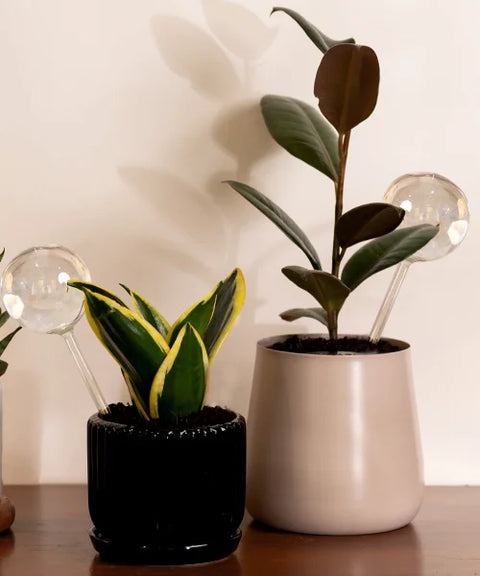Cryptanthus Plant - BYOB
₹299 ₹69957% OFF
Add to Basket
View similar
Just Water it Once a Week
Before watering, check your plants to ensure the topsoil feels dry. This helps avoid overwatering
Needs Indirect Sunlight
Place in direct sunlight for 6 - 8 hours daily.
Not Pet-Friendly
This plant and your furry friends cannot become the best buds
Low Maintenance
Medium maintenance plants need occasional watering, moderate sunlight, and regular care to stay healthy and vibrant
10 Days Guaranteed Replacement
Available on this product
Get peace of mind with Kyari’s Warranty
From 30-Day Assurance to Lifetime Protection, we’ve got your plant covered!
Add Extra Plant Warranty to Your Purchase Why Add a Warranty?
Select your preferred warranty plan to secure your plant’s health and well-being.
Kyari Protect Plus | Price: ₹79 | Validity: 30 Days | Only for 4'' Pots - ₹79
Kyari Protect Pro | Price :₹99 | Validity: Lifetime | Only for 4'' Pots - ₹99
Kyari Protect Plus | Price: ₹149 | Validity: 30 Days | Only for 5.5'' Pots - ₹149
Kyari Protect Pro | Price :₹199 | Validity: Lifetime | Only for 5.5'' Pots - ₹199
Kyari Protect Plus | Price: ₹399 | Validity: 30 Days | Only for 8'' Pots - ₹399
Kyari Protect Pro | Price :₹499 | Validity: Lifetime | Only for 8'' Pots - ₹499
Kyari Protect Plus | Price: ₹599 | Validity: 30 Days | Only for 10'' Pots - ₹599
Kyari Protect Pro | Price :₹699 | Validity: Lifetime | Only for 10'' Pots - ₹699
No test available
Get Flat 5% on orders above ₹299
>
10-Day Replacement Guarantee!
Oops! Did your plants or planters arrive damaged? No worries at all—we've got your back! Simply share a few photos with us, and we'll send you a replacement, free of charge, right away.
Quick & Easy! Your replacement will be on its way within just 2 days of raising a ticket. 🌟
We’re Here to Help! Plus, get free care tips with your order.
Add Accessories
Newly Added
45% OFF
47% OFF
Plant Straw
Variants
Small / Set of 1 / Straw Beige
- ₹199
Small / Set of 1 / Straw Green
- ₹199
Small / Set of 1 / Straw Yellow
- ₹199
Small / Set of 1 / Straw Blue
- ₹199
Small / Set of 2 / Straw Beige
- ₹369
Small / Set of 2 / Straw Green
- ₹369
Small / Set of 2 / Straw Yellow
- ₹369
Small / Set of 2 / Straw Blue
- ₹369
Medium / Set of 1 / Straw Beige
- ₹215
Medium / Set of 1 / Straw Green
- ₹215
Medium / Set of 1 / Straw Yellow
- ₹215
Medium / Set of 1 / Straw Blue
- ₹215
Medium / Set of 2 / Straw Beige
- ₹399
Medium / Set of 2 / Straw Green
- ₹399
Medium / Set of 2 / Straw Yellow
- ₹399
Medium / Set of 2 / Straw Blue
- ₹399
80% OFF
35% OFF
50% OFF
50% OFF
Sold Out
65% OFF
Sold Out
50% OFF
50% OFF
Popular plants
Plant care support
Free shipping above ₹399
High quality plants
36% OFF
Lucky Jade Plant With Self Watering Pot
Variants
Small / Red
- ₹284
Small / Black
- ₹284
Small / White
- ₹284
Small / Cream
- ₹284
Small / Green
- ₹284
Small / Grey
- ₹284
Medium / Aura - Blue
- ₹639
Medium / Aura - Green
- ₹639
Medium / Aura - Black
- ₹639
Medium / Aura - Yellow
- ₹639
Medium / Aura - Cream
- ₹639
Small Elite / Matte Black
- ₹309
Small Elite / Parrot Green
- ₹309
Small Elite / Lemon Yellow
- ₹309
Small Elite / Dusky Brown
- ₹309
Small Elite / Baby Pink
- ₹309
Small Elite / Magenta
- ₹309
Small Elite / Baby Blue
- ₹309
Small Elite / Turkish Green
- ₹309
36% OFF
Price Drop
30% OFF
Golden Money Plant With Self Watering Pot
Variants
Small / White
- ₹319
Small / Black
- ₹319
Small / Red
- ₹319
Small / Grey
- ₹319
Small / Green
- ₹319
Small / Cream
- ₹319
Medium / Aura - Blue
- ₹769
Medium / Aura - Green
- ₹769
Medium / Aura - Black
- ₹769
Medium / Aura - Yellow
- ₹769
Medium / Aura - Cream
- ₹769
Small Elite / Turkish Green
- ₹339
Small Elite / Baby Blue
- ₹339
Small Elite / Magenta
- ₹339
Small Elite / Baby Pink
- ₹339
Small Elite / Dusky Brown
- ₹339
Small Elite / Lemon Yellow
- ₹339
Small Elite / Parrot Green
- ₹339
Small Elite / Matte Black
- ₹339
30% OFF
Kyari’s Choice
30% OFF
Zamia Green - ZZ Plant With Self Watering Pot
Variants
Small / Black
- ₹349
Small / Cream
- ₹349
Small / Green
- ₹349
Small / Grey
- ₹349
Small / White
- ₹349
Small / Red
- ₹349
Medium / Black
- ₹909
Medium / Cream
- ₹909
Medium / Aura Yellow
- ₹909
Medium / Aura Green
- ₹909
Medium / Aura Blue
- ₹909
Large / Black
- ₹1,999
Large / Cream
- ₹1,999
Large / Green
- ₹1,999
Extra Large / Black
- ₹2,449
Extra Large / Green
- ₹2,449
Extra Large / Grey
- ₹2,449
Extra Large / Orange
- ₹2,449
Small Elite / Lemon Yellow
- ₹379
Small Elite / Dusky Brown
- ₹379
Small Elite / Baby Pink
- ₹379
Small Elite / Magenta
- ₹379
Small Elite / Baby Blue
- ₹379
Small Elite / Parrot Green
- ₹379
Small Elite / Matte Black
- ₹379
30% OFF
Best Seller
34% OFF
Spider Plant With Self Watering Pot
Variants
Small / Black
- ₹299
Small / White
- ₹299
Small / Cream
- ₹299
Small / Green
- ₹299
Small / Grey
- ₹299
Small / Red
- ₹299
Medium / Aura - Blue
- ₹659
Medium / Aura - Green
- ₹659
Medium / Aura - Black
- ₹659
Medium / Aura - Yellow
- ₹659
Medium / Aura - Cream
- ₹659
Small Elite / Matte Black
- ₹299
Small Elite / Parrot Green
- ₹299
Small Elite / Lemon Yellow
- ₹299
Small Elite / Dusky Brown
- ₹299
Small Elite / Baby Pink
- ₹299
Small Elite / Magenta
- ₹299
Small Elite / Baby Blue
- ₹299
Small Elite / Turkish Green
- ₹299
34% OFF
Best Seller
35% OFF
Golden Hahnii Snake Plant With Self Watering Pot
Variants
Small / Cream
- ₹439
Small / Black
- ₹439
Small / White
- ₹439
Small / Green
- ₹439
Small / Grey
- ₹439
Small / Red
- ₹439
Medium / Aura - Blue
- ₹839
Medium / Aura - Green
- ₹839
Medium / Aura - Black
- ₹839
Medium / Aura - Yellow
- ₹839
Medium / Aura - Cream
- ₹839
Small Elite / Turkish Green
- ₹459
Small Elite / Baby Blue
- ₹459
Small Elite / Magenta
- ₹459
Small Elite / Baby Pink
- ₹459
Small Elite / Dusky Brown
- ₹459
Small Elite / Lemon Yellow
- ₹459
Small Elite / Parrot Green
- ₹459
Small Elite / Matte Black
- ₹459
35% OFF
Best Seller
28% OFF
Aralia Green Plant With Self Watering Pot
Variants
Small / Black
- ₹319
Small / White
- ₹319
Small / Cream
- ₹319
Small / Green
- ₹319
Small / Grey
- ₹319
Small / Red
- ₹319
Medium / Aura - Cream
- ₹769
Medium / Aura - Yellow
- ₹769
Medium / Aura - Black
- ₹769
Medium / Aura - Green
- ₹769
Medium / Aura - Blue
- ₹769
Extra Large / Arbor - Orange
- ₹2,309
Extra Large / Arbor - Grey
- ₹2,309
Extra Large / Arbor - Green
- ₹2,309
Extra Large / Arbor - Black
- ₹2,309
Small Elite / Turkish Green
- ₹339
Small Elite / Baby Blue
- ₹339
Small Elite / Magenta
- ₹339
Small Elite / Baby Pink
- ₹339
Small Elite / Dusky Brown
- ₹339
Small Elite / Lemon Yellow
- ₹339
Small Elite / Parrot Green
- ₹339
Small Elite / Matte Black
- ₹339
28% OFF
Best Seller
29% OFF
Calathea Triostar Plant With Self Watering Pot
Variants
Small / Red
- ₹479
Small / Grey
- ₹479
Small / Green
- ₹479
Small / Cream
- ₹479
Small / White
- ₹479
Small / Black
- ₹479
Medium / Aura - Blue
- ₹979
Medium / Aura - Green
- ₹979
Medium / Aura - Black
- ₹979
Medium / Aura - Yellow
- ₹979
Medium / Aura - Cream
- ₹979
Large / Zen - Green
- ₹1,869
Large / Zen - Cream
- ₹1,869
Large / Zen - Black
- ₹1,869
Extra Large / Arbor - Black
- ₹2,769
Extra Large / Arbor - Green
- ₹2,769
Extra Large / Arbor - Grey
- ₹2,769
Extra Large / Arbor - Orange
- ₹2,769
29% OFF
Best Seller
30% OFF
Peace Lily Plant With Self Watering Pot
Variants
Small / White
- ₹339
Small / Black
- ₹339
Small / Cream
- ₹339
Small / Grey
- ₹339
Small / Green
- ₹339
Small / Red
- ₹339
Medium / Aura - Blue
- ₹769
Medium / Aura - Green
- ₹769
Medium / Aura - Black
- ₹769
Medium / Aura - Yellow
- ₹769
Medium / Aura - Cream
- ₹769
Large / Zen - Green
- ₹1,829
Large / Zen - Cream
- ₹1,829
Large / Zen - Black
- ₹1,829
Small Elite / Matte Black
- ₹359
Small Elite / Parrot Green
- ₹359
Small Elite / Lemon Yellow
- ₹359
Small Elite / Dusky Brown
- ₹359
Small Elite / Baby Pink
- ₹359
Small Elite / Magenta
- ₹359
Small Elite / Baby Blue
- ₹359
Small Elite / Turkish Green
- ₹359
30% OFF
Best Seller
Call 9201962751 upto 70% on bulk buying









 Plant care support
Plant care support
 Free shipping above ₹399
Free shipping above ₹399
 High quality plants
High quality plants









































































































































































































































 Apply Discount at Checkout
Apply Discount at Checkout 

































